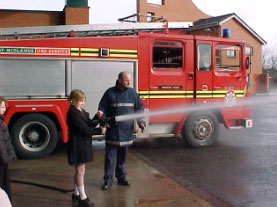KS2 Design Technology Project: Personal Protective Equipment

Preparation and planning
This module of work was planned as part of "Technology Tree", an Engineering Employers' Federation project. It was designed by Jen Collins, Key Stage 2 Co-ordinator at Woodgate Junior and Infant School, Birmingham and RoSPA's Safety Education team. Technical information about firefighters' PPE was supplied by HM Fire Service Inspectorate and by West Midlands Fire Service Collaboration with West Midlands Fire Service would involve visits to school by a Community Firefighter and children would visit a local fire station. A collection of protective gloves was assembled from manufacturers, DIY stores and sports shops. Marigold Industrial provided a wide range of samples.
The learning objectives
A 12-week module of work was taught to Year 5 to cover the following learning objectives:
-
To establish children's understanding of PPE in everyday life by examining cycle helmets, swimming goggles, etc.
-
To prepare for a visit to school from a community firefighter
-
To learn about the properties and uses of firefighters' PPE
-
To learn about fire safety in relation to house fires. This included completing the West Midlands Fire Service Fire Safety at Home checklist
-
To prepare for a visit to a fire station
-
To review the visits, clarify learning and write letters of thanks
-
To explore the properties and uses of a range of protective gloves including domestic, gardening, medical and industrial
-
To investigate and record the effects of gloves on dexterity
Dexterity Lesson Worksheet (PDF 17kb)
-
To disassemble commercially produced oven gloves
-
To design and make a paper prototype of a mitten style oven glove, evaluating and modifying size and fit
-
To make a paper pattern from the prototype
-
To cut out pieces for the casing, wadding and lining
-
To assemble a glove by sewing
-
To test the product in a practical situation.
Please note: the oven gloves were made under constant supervision. The gloves were carefully checked by the teacher before being tested under supervision by lifting warm (but not hot) trays out of an oven. Teachers would need to satisfy themselves of the safety of the gloves if they were to be taken home and used in a kitchen.
Further information for teachers
Teaching about safety
There are lots of opportunities to teach about safety in design and technology work:
-
Using tools and equipment safely when making products
-
Making sure that the products you make are safe e.g. no sharp edge or choking hazards
-
Investigating products specifically designed to keep people safe e.g. oven gloves, cycle helmets and life jackets
-
Looking for safety symbols on commercial products, e.g. BEAB and the BSI Kitemark.
When evaluating the quality of a product (3c), safety should be included among the social, economic and environmental considerations.
The firefighters' gloves and most other gloves investigated in this project conformed to European or British Standards. This shows that they have been tested for certain properties e.g. they are waterproof, fireproof or cutproof, depending on their intended use. All personal protective equipment (PPE) in the EC is required to carry a CE mark. This is a manufacturer's claim that the product complies with the essential requirements of Directive 89/686/EEC.
There is a British Standard for domestic oven gloves, BS No 6526:1998 so look out for this when buying gloves to ensure a high standard of protection.
Which? reports can give useful information about the safety of products.
Safety guidance
Consult any guidance published by your L.E.A. about safety in design and technology.
The British Standards Institution have produced a code of practice: Health and Safety for Design and Technology in Schools and Similar Establishments - Code of practice BS 4163:2000.
Choosing suitable materials
A survey of oven gloves by the laboratory of the government chemist, found cotton fabric for the outer casing and polyester wadding to be most successful. Polyurethane foam gloves performed badly.